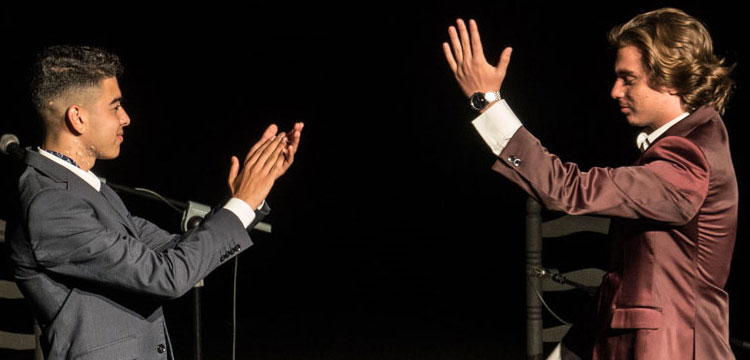Alonso El Purili, Manuel de la Tomasa y Manolo Franco «Contrastes»– Flamenco Madrid
If only Ava Gardner were alive
José Manuel Gómez Gufi
“The more and better flamenco there is in Madrid, the better it is for everyone”, repeats Juan Manuel del Rey, director of Corral de la Morería, the venue that has been receiving the cream of flamenco since the 1950s. Years when Ava Gardner was the last one to leave the flamenco hangouts of the city, from 1952 to 1957, and if she still wanted more, she’d take the flamencos back to her house, even in the face of resistance, such as the ex-president of Argentina, Perón himself.
Ava went to live in London and when she was brought some recordings to cure her nostalgia, she said that thing of: “it’s not the same”. There are people who think flamenco is like hard drugs in the sense that whatever got you hooked in the first place, it’s very hard to break away. Which is why there are people who joke that it ought to be prohibited: “like bullfights in Catalonia, let’s see if they put a TV program and devote tons of pages in the newspapers”. And the flamenco fans again resort to irony: “since Rosalía came on the scene to make flamenco fashionable, newspapers talk of nothing else except…talking about Rosalía”.
If Ava Gardner were alive, she would have taken Purili and Manuel de la Tomasa to sing all night. Alonso Purili and Manuel are two of the great young hopefuls of traditional flamenco singing, studious and steeped in the essence of cante. Both are on the verge of turning 20, but have spent half their lives in the art (literally, since before actually knowing what flamenco was) and the visionaries have said they are the future, because they are devoted to interpreting the past, so they’ve made the rounds of the Madrid venues (sala García Lorca and Círculo Flamenco) where the most ardent followers this writer knows congregate.
They began facing off a capella, then Manolo Franco came on, an institution of the guitar.
El Purili began with taranta and sang:
“Ay mi muchacho
que hace tres días que yo no lo veo
a dónde andará mi muchacho
si estará bebiendo vino
y me lo traen a mi borracho
ay si alguna mujer me lo ha entretenío”
[Where can my boy be, I haven’t seen him in three days,
maybe he’s drinking wine and they’ll bring him back drunk,
or some woman has seduced him].
From the content, you can tell the verse is old; it was recorded by Bernarda with Juan Habichuela in the era Gardner was making the rounds of Madrid tablaos. That’s where you look around to see who identifies with the story and you see that Purili is singing extraordinarily well, but who can take the verse seriously? Naive foreigners?
We repeat: there are NOT enough naive foreigners for so much flamenco. “Guiris” (meaning people who come from outside flamenco) are the best audience I know. There are people who see you taking notes and ask:
-What did he say?
– I have no idea.
Between one thing and another, if Ava had been present, she would have given Purili, who continued to sing things of his grandfather’s, a run for his money:
-“diez céntimos le dí a un pobre…” [“ten cents I gave a beggar…”]
How do you identify with something like that? He’s talking about pesetas! A boy who was born in the year 2000!
I guess I’m not supposed to be commenting on the verses, I ought to talk about the singing. Well, as far as that goes, it was top of the line.
Then Manuel de la Tomasa came on wearing a burgundy-colored suit, he aimed to come out on top one way or another, and he also sang in the old style. He began announcing changes in the script, he had been going to sing malagueñas “but Alonso inspired me and I’m going to do soleá instead”, and he served up a bullfighting theme:
“Sevilla tiene a Curro/ Jerez a Rafael” [Seville has Curro / Jerez has Rafael] which means the verse is a few years old because the person who is putting his life on the line in the bull-ring in this San Isidro fair is from Peru.
He sang alegrías and got into siguiriyas. Seated at first, he finished more comfortably standing, with full lung-power. It’s not usual to sing siguiriyas standing, and it was the best thing of the night with the sobriety of Manolo Franco’s guitar.
Videos:
Photos (MJ. Lara)
